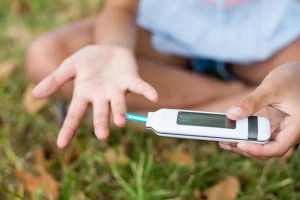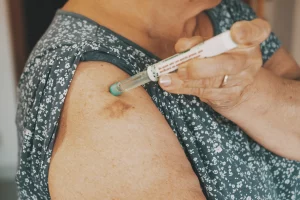There are different types of diabetes, if you have diabetes, your body does not use insulin well. Insulin is a hormone that helps move blood sugar into your cells to give them energy.
Over time, having too much sugar in your blood can cause severe problems with your heart, eyes, kidneys, nerves, gums, and teeth. Diabetes can also make it hard for you to heal from cuts and bruises.
You can take steps to lower your chance of getting diabetes. These steps include controlling your weight, eating healthy foods, exercising daily, and ensuring your blood sugar levels are in the target range. If you already have diabetes, these steps will help keep your diabetes under control and prevent diabetes complications.

Causes of Diabetes
There are different types of diabetes, but type 2 diabetes is the most common. In type 2 diabetes, your body does not use insulin properly, which is called insulin resistance. Insulin resistance may happen due to several things, including:

– Being overweight or obese
– Having a family history of diabetes
– Not being physically active
– Having high blood pressure
– Having abnormal cholesterol and triglyceride levels in your blood
– Having a history of gestational diabetes (diabetes during pregnancy)
– Giving birth to a baby that weighed more than 9 pounds
– Polycystic ovary syndrome (PCOS)
– Sleep apnea
It’s unclear why some people develop insulin resistance while others don’t. But we know that insulin resistance is more common as a person ages, especially if you are overweight or obese. Insulin resistance can also run in families.
Difference in Types of Diabetes
There are three main types of diabetes: type 1, 2, and gestational diabetes.
- Type 1 Diabetes: Type 1 diabetes is usually diagnosed in children, adolescents, or young adults. In this form of diabetes, the body does not produce insulin. Insulin is a hormone that helps move blood sugar into your cells to give them energy. Without insulin, too much sugar stays in your blood. People with type 1 diabetes must take insulin daily to stay alive.
- Type 2 Diabetes: Type 2 diabetes is the most common form of diabetes. It usually develops in middle-aged or older adults but can occur in children, adolescents, or young adults. In type 2 diabetes, your body does not use insulin well, which is insulin resistance. At first, your pancreas makes extra insulin to make up for it. But, over time, it can’t keep up and can’t make enough insulin to keep your blood sugar at normal levels.
- Gestational Diabetes: Gestational diabetes develops in some women when they are pregnant. Sometimes diabetes diagnosed during pregnancy is type 2 diabetes. Most of the time, this type of diabetes goes away after the baby is born. However, if you’ve had gestational diabetes, you have a greater chance of developing type 2 diabetes later in life.
No matter what type of diabetes you have, it’s essential to manage your diabetes and stay healthy. With proper care, you can prevent or delay complications from diabetes. And if you have type 2 diabetes, you may be able to reverse it.

How Is Diabetes Diagnosed?
A fasting blood sugar test is usually done to diagnose diabetes. On two separate tests, a fasting blood sugar level of more than 126 milligrams per deciliter (mg/dL) indicates that you have diabetes.
A random blood sugar test can also be used to diagnose diabetes. A blood sugar level of more than 200 mg/dL indicates diabetes.
Prediabetes means that you are at high risk for developing type 2 diabetes. You have prediabetes if your fasting blood sugar is between 100 and 125 mg/dL. If you do not make lifestyle changes, such as losing weight and increasing your physical activity, you may develop type 2 diabetes within five years.
A1C Test
The A1C test is another way to diagnose diabetes and prediabetes. The A1C test measures your average blood sugar level for the past two to three months. An A1C level of 6.5% or higher on two separate tests indicates diabetes. An A1C level of 5.7% to 6.4% means you have prediabetes.
If your test results are abnormal, you must be retested another day to confirm the diagnosis.
What Type of Diabetes is the Worst?
All types of diabetes can lead to serious health complications if they are not managed well. But type 2 diabetes is often worse than other types of diabetes because it develops gradually and may not have any symptoms for years. When people with type 2 diabetes see their doctor, they often already have other medical problems, such as heart disease or kidney disease.
Type 1 diabetes is also severe but is usually diagnosed early and treated aggressively. People with type 1 diabetes often have reasonable blood sugar control and do not develop the same long-term complications as people with type 2 diabetes.



